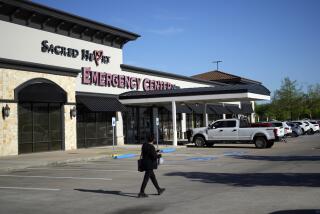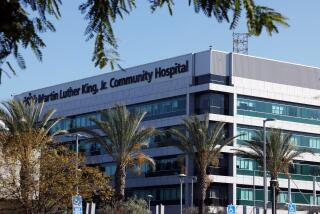‘Free Hospital of Texas’ Is a Little Less So
GALVESTON, Texas — Uninsured and diagnosed with cancer, Jerry Wayne Grimes knew where to turn for help: the University of Texas Medical Branch at Galveston, a teaching hospital 100 miles from his home.
Grimes received chemotherapy at the hospital five days a week for three months ending in October. He paid nothing--the hospital absorbed the cost and even paid for a hotel to ease his commute.
“He clearly needs the care,” said Jean McDaniel, practice coordinator in the hospital’s oncology division, noting that if Grimes had delayed treatment, the cancer could have spread quickly and killed him.
Grimes case’ is emblematic of how Texas’ oldest teaching hospital became “The Free Hospital of Texas.”
But it’s a title the hospital can no longer afford. It lost nearly $49 million in the fiscal year ended last August, largely due to the rising cost of treating the uninsured and to declining fees paid by private and government health insurance programs.
Although at least two dozen major U.S. teaching hospitals are losing money, the hospital’s aggressive response--particularly in rationing care to the uninsured--sets it apart from other institutions.
In addition to laying off 390 of its 13,000 employees last year, the hospital:
* Required all uninsured patients to get nonemergency care in their home counties instead of traveling to the hospital’s clinics.
* Mandated that all uninsured patients pay $12 for doctor visits, $10 for each prescription drug and $100 for hospital admissions. Before the change, they often paid nothing.
* Curtailed the use of translators, a big issue where a large part of the population speaks Spanish.
* Closed its home health care agency that sent nurses to patients’ homes.
Hospital officials say they will never turn away emergency patients regardless of their ability to pay, in part because the law forbids it. But everyone else must pay or go elsewhere. Patients like Grimes are now the exception, not the rule, for how the hospital treats the uninsured.
In cases like Grimes’, a patient can only get free care after a committee of hospital doctors, social workers and administrators approves it. There was no other place where Grimes could receive the treatment but there.
Like other U.S. hospitals, the University of Texas Medical Branch first reacted to its growing deficit by cutting staff. But it quickly realized that wasn’t enough.
“We decided we were going to ration care,” said Dr. John Stobo, the hospital’s president. “Business as usual is over for the academic health centers.”
The institution, along with other hospitals, for years provided free care for the uninsured by charging higher fees to those covered by government or private insurance. But reduced payments from HMOs and Medicare combined with the rising number of uninsured forced the hospital to cut back.
The main cause for the rise in uninsured has been the booming Texas economy. More Texans are getting jobs and leaving public assistance programs that provided health insurance coverage, but many of their jobs don’t include health benefits.
From 1996 to 1998, the number of uninsured treated at the hospital rose from about 248,000 to nearly 270,000. The cost of that care increased from $135 million in 1996 to $158 million in 1998. The hospital’s total budget is about $1 billion.
Meanwhile, Medicare cuts are projected to lower the hospital’s revenue by $50 million between 1998 and 2002.
The University of Texas Medical Branch made arrangements with several counties to have their indigent-care programs cover patients. But Ralph Morris, executive director of the Galveston County Health Care District, said, “There’s no question in my mind that what has happened to the vast majority of patients is that they probably are not receiving care until a true emergency happens.”
Meanwhile, at the hospital, Dr. Joan Richardson, the medical director for inpatient care, said the medical staff has had to adjust to a new business perspective.
“In years past, doctors did not hesitate to operate or do a procedure on a patient without a care for insurance,” she said. Today, doctors realize they have to get permission.
“We’ve been forced to understand the impact of the bottom line,” Richardson said.
With that philosophy, there are no more routine X-rays to all patients in the intensive care unit and patients may have to wait longer in the emergency room before getting a room, because the hospital has eliminated about 130 beds. Emergency room doctors used to give a free 30-day supply of drugs to everyone, but no longer.
Although painful, the hospital’s efforts to reduce demand for free care are having desired results.
The cost of treating the uninsured dropped to $135 million in 1999 from $147 million in 1998. Emergency room visits fell 10% last year to about 80,000, an indication that patients realize they won’t be able to get emergency care for routine services.
More to Read
Sign up for Essential California
The most important California stories and recommendations in your inbox every morning.
You may occasionally receive promotional content from the Los Angeles Times.










